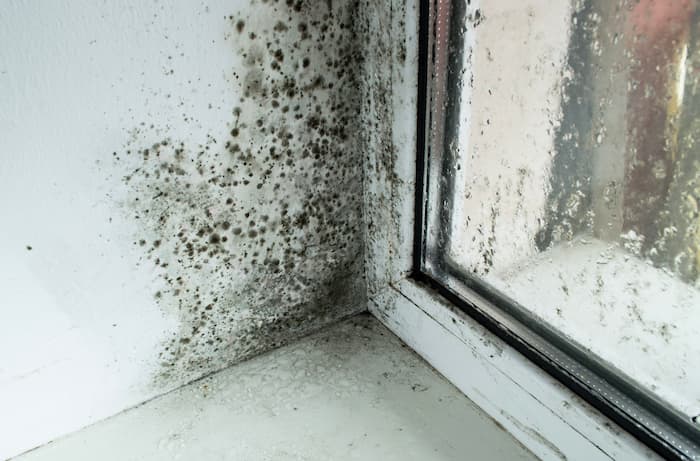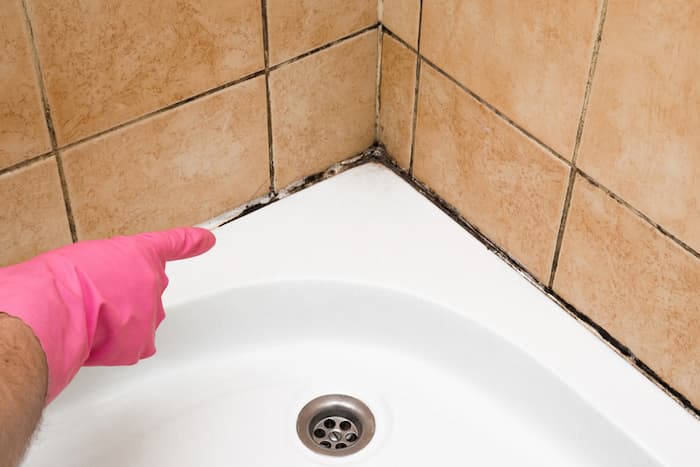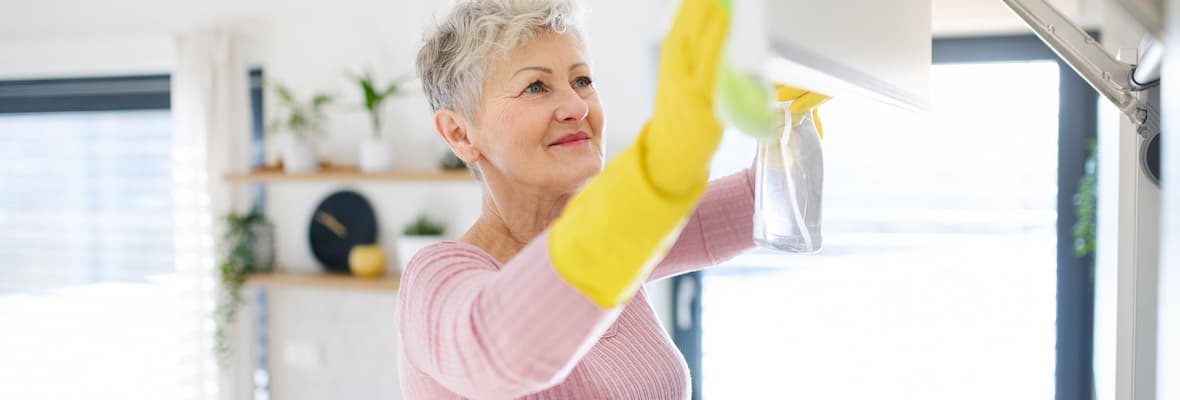It can be frustrating to have mould in your home. Not only is it not very nice to look at, but it can also become a serious health risk if left untreated.
But rather than throwing away mouldy items, we've explored different ways you can remove mould as safely as possible in your home.
So whether you're looking to get rid of mould or prevent it from appearing in the first place, check out our guide below.
What is mould?
Mould is a type of fungi that grows in poorly ventilated, moist areas. It spreads through tiny particles known as mould spores.
These spores travel through the air to find somewhere damp and warm to grow. Mould can be found inside or outside a home, but it tends to be more of an issue indoors where there is less fresh air.

The first signs of mould might just look like slight discolouration or a stain. After a while, it can change colour and start to appear fuzzy in texture.
There's a range of different mould species which can come in many different colours.
Black mould, green mould and white mould tend to be the most common, but you might also see mould that is grey, orange or brown depending on how old it is and what type of mould it is.
Mould or Mildew
It can be tricky to know the difference between mould and mildew because they look so similar.
Both are types of fungi and although mildew can be less serious, they can both be harmful if left untreated.
Mildew |
Mould |
|---|---|
Typically found in wet areas such as in a laundry or bathroom |
Found in damp, warm, poorly ventilated areas such as a bathroom or kitchen |
Lives on the surface of a material |
Attaches to materials and penetrates beneath the surface |
Can be easier to remove and less of a threat |
Harder to remove |
Known to affect crops and plants |
Can rot materials over time |
Usually grows in a flat pattern |
Range of shapes, patterns, colours |
Grey or white appearance which can turn yellow or brown |
Fuzzy or slimy in texture |
Why It’s Important to Get Rid of Mould
Mould growth can result in some serious health problems, particularly for those with weakened immune systems. This is why you should understand how to get rid of mould as early as possible.
Inhaling, ingesting or coming into contact with mould can trigger:
- Nasal congestion
- Sneezing
- Coughing
- Wheezing
- Respiratory infections
It can also worsen symptoms for those who already suffer from asthma and allergies.
Those with weakened immune systems, allergies, asthma and chronic, obstructive or allergic lung diseases should be the most careful around mould.
How to Remove Mould from Fabric
Finding mould on your clothes or fabric furniture is never fun. While you might be inclined to just throw the item away, with the right steps, it could be saved.
Cleaning mould from fabric can be done in a few ways. These include:
- Hot water: Wash your clothes in water that is at 60oC or more for at least 10 to 30 minutes. This can kill mould spores but it won't prevent mould from returning. Hang in the sun to dry for the best results.
- Vinegar and baking soda: Mix two parts baking soda to one part white vinegar in a bucket of hot water. Soak clothes in the mix before washing and it should help kill mould and remove stains. You can also mix the vinegar and baking soda into a paste to cover mould-affected areas on furniture. Once completely dried, remove the paste with a vacuum.
- Borax: Borax is known to be effective at removing mould. It's also water soluble so you can just add it to a load of washing. It's worth spot-testing this as well and making sure your clothes can handle the wash without being damaged.
- Rubbing alcohol: Pour a small amount of alcohol on mould stains on your fabric couch. Use a brush to scrub the mould and wipe away with a wet cloth. Make sure it dries completely.
How to Clean Mould Off Walls
When attempting to clean mould off walls, start with a simple solution before moving on to heavy-duty cleaners.
You can first try using a mild detergent, such as sugar soap, and a microfibre cloth to clean mould off walls, floors and tiles. If it turns out to be a stubborn mould, try using a diluted vinegar solution or diluted bleach solution with a soft cloth.
Always make sure you wipe off any excess moisture after cleaning the area as mould feeds on damp areas.
How to Remove Mould from Ceiling
It can also be common for mould to grow on the ceiling in places such as the bathroom, laundry and kitchen.
To remove mould from the ceiling you can:
- Fill a spray bottle with a diluted vinegar solution.
- Cover the mouldy areas with the solution.
- Leave for an hour to break up the mould.
- Use warm water and a scrubbing brush to remove the mould.
- Wipe the surface clean and dry.
Make sure you're wearing the right protective clothing including a face mask and eye protection when cleaning mould off the ceiling.
How to Get Rid of Shower Mould
The bathroom can be one of the most frustrating places to find mould. It can grow in drains, on the walls, in grout and in silicone sealant.
These can be tough spots to tackle, so you should make sure you're equipped with the right tools to get rid of shower mould.

Mould in Silicone
To remove mould from silicone sealant in showers, you can:
- Mix an 80/20 water and white vinegar solution with baking soda to make a paste.
- Apply the paste over the affected areas and use a toothbrush or small scrubbing brush to cover all bases.
- Cover with plastic wrap and let stand for two hours.
- Remove the plastic wrap and wash the solution off.
Mould on Drains and Walls
To remove mould from drains and walls, you can:
- Mix an 80/20 water and vinegar solution in a spray bottle.
- Spray over the drain area and affected walls and let stand for 10 minutes.
- Use a scrubbing brush to remove mould from the affected areas.
Mould in Shower Grout
To remove mould in shower grout, you can:
- Mix an 80/20 water and vinegar solution in a spray bottle.
- Spray solution over the affected grout area and use a nylon brush to scrub mould off the grout.
- Rinse the area clean.
What Not to Do When Removing Mould
When you're removing mould, there are a few things you should avoid.
Never Dry Brush
Never dry brush mould as this can release mould spores back into the air and allow them to spread further.
It can also bring on an allergic reaction or worsen asthma for anyone who inhales the spores.
Take Care With Chemicals
Store-bought mould removers can contain harsh chemicals that can be hazardous if they aren't used correctly.
Make sure you wear protective clothing including rubber gloves, a mask and eye protection. If you're working on indoor surfaces, only clean mould with proper ventilation in the room.
It's also worth knowing that some cleaners might only use a bleach solution that will just bleach the mould instead of killing it, meaning the problem will likely return.
Harsh chemicals can also discolour surfaces in your home so make sure to do a spot check before you commit to a full clean.
Know When to Throw it Out
In situations such as floods or prolonged rain, you might find it hard to get your items completely dry before mould grows.
If porous surfaces such as carpets, mattresses, leather goods or ceiling insulation have been wet for more than two days, you're best to either take them to a professional mould cleaner or just get rid of them.
Mould Prevention Tips for the Rainy Season
Like most things in life, prevention is better than a cure when it comes to mould. Preventing mould can be tricky if you live in a wet area or if it's hard to get adequate ventilation in certain rooms in your home.
But there are always steps you can take to help make sure you remove mould permanently from your home.
Generally, to avoid extra moisture in your home, you can:
- Fix plumbing and roofs and any other water leaks in the home
- Regularly clear and maintain gutters
- Use exhaust fans and open windows when using the kitchen and bathroom
- Regularly clear condensation on windows and showers
- Get fresh air into the home by opening windows and doors
- Use a dehumidifier and/or air purifier
- Use a vacuum cleaner with a high-efficiency particulate air (HEPA) filter
- Make sure mattresses are off the floor on a ventilated base
- Vacuum and turn mattresses
- Move furniture away from walls to increase air circulation
- Move plants, bushes and soil away from walls as they hold moisture
The risk of mould can also increase after severe weather such as prolonged rain, floods, storms or cyclones. In these cases, you should start the drying-out process as soon as possible.
Once the wet weather has eased, make sure you open all the doors and windows and use fans and air-conditioners (on dry mode) to speed up the ventilation process.






